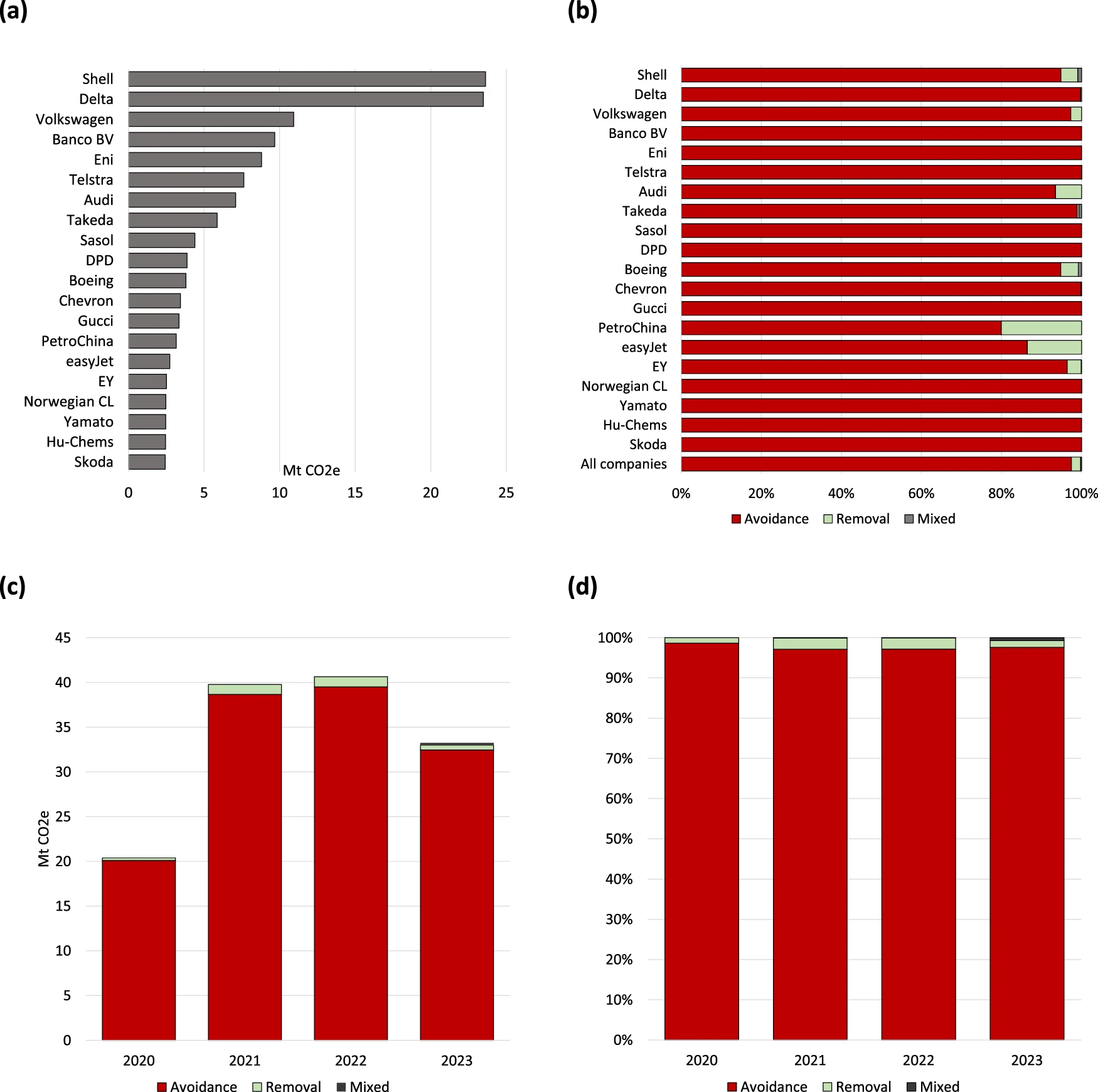The Double-Edged Sword of Carbon Offsets
In the quest for climate neutrality, carbon offsets have emerged as a popular tool purported to balance out greenhouse gas emissions by funding equivalent carbon dioxide saving projects. However, recent studies and expert critiques raise significant doubts about their effectiveness and ethical implications. This article delves into the controversies surrounding carbon offsets, examining their role in corporate environmental strategies and their actual impact on our planet’s health.
The Reality of Carbon Offset Effectiveness
Recent systematic reviews and investigations expose a troubling panorama where the majority of carbon offset projects fail to deliver on their promises. According to Probst et al., 2024, only 12% of voluntary carbon offset credits result in genuine emissions reductions. Particularly concerning is the revelation that sectors like renewable energy and cookstoves are almost ineffective in delivering real cuts, with respective success rates of 0% and 0.4%.
These findings are echoed by a correspondence from 34 international scientists published in Nature, which warns that most voluntary carbon offsets do not robustly neutralize fossil fuel emissions. They call for a rigorous public peer review system to evaluate the effectiveness of these offsets more transparently.
Corporate Reliance on Questionable Offsets
Trencher et al., 2024 highlights a worrying trend among corporates – an overwhelming preference for cheap, low-quality offsets that hardly meet critical standards like additionality and permanence. This trend is not just limited to small players but includes some of the largest global corporations. In fact, 87% of offsets purchased by top corporate buyers are classified as high-risk for not providing real emissions reductions.
This corporate behavior fosters what critics describe as a “license to pollute,” enabling businesses to continue harmful environmental practices while ostensibly achieving net-zero emissions through questionable offset credits.
Technological Innovations in Carbon Offsetting
On a more positive note, there are advancements in technology that could enhance the verifiability and reliability of carbon offsets. Increased use of satellite data and remote sensing has improved our ability to monitor forest carbon stocks accurately, potentially addressing issues like leakage or reversals due to wildfires.
Moreover, developments in durable carbon removal technologies such as biochar and blue carbon projects offer hope for long-term sequestration solutions that could eventually replace less reliable avoidance-based offsets.
Diverse Perspectives: Experts Weigh In
The debate around carbon offsets is diverse and spirited. On one end, proponents argue that carbon offsets, despite their flaws, play a crucial role in financing essential climate action projects. On the other side, critics argue these mechanisms allow continued environmental degradation under the guise of progress.
Experts from various fields stress the importance of integrating robust verification processes and adopting stronger regulatory frameworks to ensure that carbon offsetting fulfills its intended purpose without unintended ecological or social harm.
Moving Forward: Policy Recommendations and Future Directions
Given the complexities and challenges associated with current carbon offsetting practices, it’s crucial to foster policies that prioritize direct emissions reductions over compensatory measures. Regulatory changes such as those proposed under the EU Green Claims Directive offer a path forward by banning unsubstantiated offset claims and stressing mitigation within value chains rather than external compensations.
Furthermore, embracing community-led conservation efforts can ensure that local populations who are most impacted by climate change have a say in the projects developed in their own backyards, potentially leading to more sustainable and accepted outcomes.
KEY FIGURES
- Only 12% of total voluntary carbon offset credits represent real emissions reductions; the rest (88%) do not deliver genuine cuts, with 0% for renewable energy, 0.4% for cookstoves, 25% for forestry, and 27.5% for chemical processes (Source: Probst et al., 2024 systematic review[1]).
- 87% of offsets bought by the top 20 corporate buyers in the voluntary carbon market between 2020-2023 are classified as low-quality and at high risk of not providing real and additional emissions reductions (Source: Trencher et al., 2024[4]).
- Only 6% of carbon offsets produced by 18 REDD+ forest conservation projects across five tropical countries were found to be valid, highlighting overestimation issues in forest carbon offsets (Source: Erin Sills et al., 2024[5]).
- The offset achievement gap corresponds to nearly double the annual CO2 emissions of Germany (Source: Probst et al., 2024[1]).
RECENT NEWS
- May 2024: A group of 34 international scientists published a correspondence in Nature, warning most voluntary carbon offsets are not robust or capable of neutralizing fossil fuel emissions, calling for systematic public peer review of offset effectiveness and transparency in Science-Based Targets initiatives (Source: CREAF, 2024[2]).
- August 2024: Study revealed major companies predominantly purchase cheap, low-quality offsets with high risks of inflated emissions reductions, undermining net-zero claims (Source: Nature Communications, 2024[4]).
- January 2024: Researchers emphasized that many REDD+ forest conservation projects overestimate their emissions reductions, raising serious doubts about their climate effectiveness (Source: NC State, 2024[5]).
STUDIES AND REPORTS
- Probst et al. (2024) systematic review of >2000 offset projects: Majority of voluntary offsets fail to deliver promised emissions reductions. Carbon removal credits with durable, long-lived storage are recommended over avoidance-based offsets, particularly for fossil fuel emissions (Source: [1]).
- Trencher et al. (2024): Analysis of corporate offset buying patterns reveals preference for low-cost, low-quality credits that fail to meet standards of additionality, permanence, and leakage, suggesting corporate demand drives quality issues (Source: [4]).
- Study by Sills et al. (2024) on REDD+ offsets: Only a small fraction (~6%) of forest offsets are valid; challenges include baseline inflation, leakage, and monitoring weaknesses (Source: [5]).
- 34 scientists’ letter in Nature (2024): Calls for transparency, improved methodologies, and critical review of offset protocols to ensure real climate benefits (Source: [2]).
- PPIC expert interview (2023) highlights difficulty in accurately establishing baselines for forest management offsets and the risk that offsets may not represent additional emissions reductions (Source: [3]).
TECHNOLOGICAL DEVELOPMENTS
- Increasing use of satellite data and remote sensing to verify forest carbon stocks and detect leakage or reversals such as wildfire impacts, improving monitoring accuracy (Inferred from multiple sources referencing verification challenges and independent audits).
- Development of carbon removal credits focused on durable storage (e.g., biochar, blue carbon) as alternatives to traditional avoidance offsets, aiming for long-term atmospheric carbon sequestration (Source: Probst et al., 2024[1]).
- Emerging registries and rating firms are evolving to incorporate stricter verification standards and risk assessments to address baseline inflation, permanence, and leakage issues (Referenced in scientific correspondence and market analyses[2][4]).
Volume of offset retirements and proportion of emissions avoidance and emissions removal.
- a Absolute volumes of all offsets retired by each company over 2020–2023.
- b Relative shares of avoidance or removal offsets retired over 2020–2023. Both panels show aggregated yearly results for each company that appear in Table S3a, b.
- c Absolute volume of avoidance and removal offsets for all companies by year.
- d Relative share of avoidance and removal offsets for all companies by year. Classification into avoidance, removal and mixed follows the University of California Berkeley’s Voluntary Registry Offsets Database64.
MAIN SOURCES
- https://files.sciencebasedtargets.org/production/files/Call-for-Evidence/290_Probst_Systematic_review_of_the_actual_emissions_reduction.pdf – Systematic review quantifying the credibility gap in voluntary carbon offsets across sectors.
- https://www.creaf.cat/en/articles/nature-gives-voice-34-scientifics-questioning-robustness-voluntary-offsets-and-carbon-credit-protocols – Scientists’ letter in Nature questioning voluntary offset robustness and calling for transparency.
- https://www.ppic.org/blog/are-carbon-offsets-actually-working/ – Expert discussion on California’s carbon offset program and challenges with forest management offsets.
- https://www.nature.com/articles/s41467-024-51151-w – Analysis of corporate demand for low-quality offsets and implications for climate mitigation.
- https://cnr.ncsu.edu/news/2024/01/forest-carbon-offsets/ – Overview of REDD+ forest offsets, their benefits, and significant challenges in validation and impact.
This synthesis reveals that while carbon offsets can play a role in climate strategies, the vast majority of current voluntary offsets lack robust evidence of real, additional, and permanent emissions reductions, often enabling continued emissions under a “license to pollute.” Scientific consensus increasingly favors a shift toward durable carbon removal technologies, rigorous verification, community-led conservation, and policies that prioritize direct emissions cuts and demand reduction rather than reliance on offsets with questionable impact.
files.sciencebasedtargets.org – Systematic review of the actual emissions reductions of …
creaf.cat – Nature gives voice to 34 scientifics questioning the …
ppic.org – Are Carbon Offsets Actually Working?
nature.com – Demand for low-quality offsets by major companies …
cnr.ncsu.edu – 3 Reasons Why Forest Carbon Offsets Don’t Always Work
nature.org – Source
conservation.org – Source
en.wikipedia.org – Source
offsetguide.org – Source
acrcarbon.org – Source
carboncredits.com – Source
verra.org – Source
growbilliontrees.com – Source
offsetguide.org – Source
gba.org – Source
reuters.com – Source
nytimes.com – Source
news.mongabay.com – Source
cri.org – Source




